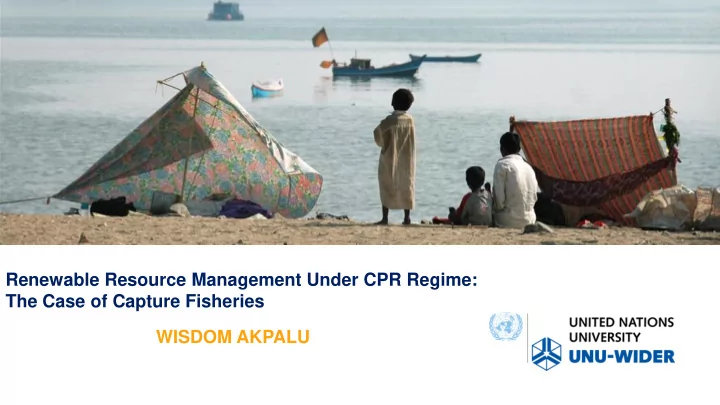

Renewable Resource Management Under CPR Regime: The Case of Capture Fisheries WISDOM AKPALU
Introduction • Renewable resources e.g. wild fish stocks, aquifers and grazing fields self-generate – Could provide perpetual flow of goods and services – Renewable Resources could benefit poor communities more than gold and diamond, – Vital roles played by RNR in DCs are hardly captured in GDP statistics! • In the world's poorest regions natural resources are communally owned (CPRs) • Access usually restricted to individuals with historic rights • Unregulated commons are subject to overuse
Introduction …. • A situation Hardin (1968) termed "the tragedy of the commons" • However, access to CPRs are restricted making it possible to avoid the tragedy • State property regimes to address resource degradation weakens local customary regimes • BUT if private cost of harvest is low socially optimum usage may deviate from the first best costless cooperative solution
Introduction...... • Capture fisheries in SSA – About 10 million people are engaged in small- scale fishing, processing, and trading – Fisheries generates US$2b in direct revenue; and US$5b indirectly • More than half of Africa’s population relies on forests for their livelihoods. • Groundwater is the main source of water for 70 % of the population of SADC • However, most these renewable NRs are currently either fully or overexploited
Introduction …. Catch loss 1991 – 2000.
Introduction …. Other Factors contributing to over-extraction: Weak management institutions: • Most NR are managed as de facto open access. • Congestion externality triggers rent dissipation. Misperception/ignorance: – misperception of stock dynamics Political capital • Perverse incentives for political expediency E.g., Harvest subsidy;
Introduction ….
Introduction …. What is the Optimal Tax on effort that can result in first best outcome under CPR?
A simple Theoretical Model • Suppose the stock dynamic equation is given by equation , ( , ) x g x K H x E x • In steady state 0 ( , ) ( , ) ( , ) H x E g x K x x E K • The equilibrium harvest function (i.e., yield function) , Y H E K
Fish stock as a common-pool resource (CPR) • Suppose the stock is exploited as a CPR, then for comm i : E i , s Y pH E K i i E • The instantaneous net benefit for community i is E i , , , E K s E K cE H E K cE i i i i i i E • If maximized and symmetry assumed, we have: , d E K 1 1 i 0 1 AR MR c d E n n i
Graphing CPR cE i , Y H E K
Optimum Policy Instrument (tax) • Let a tax be imposed on cost per unit effort so that 1 1 1 AR MR c 1 n n • Since ( at E=E *) 𝑁𝑆 = 𝑑 1 1 1 1 1 n ta x ( ) 1 1 n n n MR • Where is yield elasticity of effort. AR
Graphing the elasticity
Characterizing the tax • Taking the comparative statics of the tax we have 1 1 0 2 n n – Tax must increase if number of fishers increase 1 1 n 0 2 n – Tax must decrease if the elasticity decreases
The dynamic model • The preceding discussions are based on static analysis with no discounting! • Suppose that future benefits and costs are discounted at a positive rate (delta>0).
CPR and Optimum tax for First Best solution • The tax expression is p c x tax ( ) p c x n 1 • The following are the comparative static analysis 0, 0 , 0 n p
Empirical Illustration of the Optimum Taxes • Data on artisanal fisheries in Ghana is used to compute the yield function and the optimum effort. • The nation’s capture fishery stocks are generally managed as unregulated commons • aggregated monthly data on artisanal catch and effort of 185 fishing communities along the coast of Ghana between 2000 and 2006
CPR and Optimum Tax under dynamic optimization
CPR and Static Optimization • The yield function is 2 1 2 Y K E Kr E • Using data on artisanal fishing in Ghana, the estimated yield function is: 2 . . Y 0 439 E 0 0000023 E • c p The CPE and price are: $95.88US $264.36US
CPR and Static Optimization cont.. • The optimum effort is 0.439 0.362687 * 16589.73 E 0.0000046 • The corresponding elasticity is 0.90481 • Using 185 fishing communities the tax rate is 1 1 185 1 1 0.90481 n 0.105 185 0.90481 n
CPR and Tax Dynamic optimization
Conclusion • A large proportion of the world’s poor depend on renewable natural capital in rural areas • The RNR could be more beneficial than Gold and Diamond! • In the absence of adequate rules such resources are typically overused. • A tax rate cld to internalize resource use externality
www.wider.unu.edu Helsinki, Finland THANK YOU
Recommend
More recommend